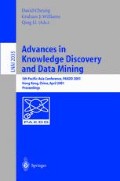Abstract
We present the S 2-Tree, an indexing method for subsequence matching of spatial objects. The S 2-Tree locates subsequences within a collection of spatial sequences, i.e., sequences made up of spatial objects, such that the subsequences match a given query pattern within a specified tolerance. Our method is based on (i) the string-searching techniques that locate substrings within a string of symbols drawn from a discrete alphabet (e.g., ASCII characters) and (ii) the spatial access methods that index (unsequenced) spatial objects. Particularly, the S 2-Tree can be applied to solve problems such as subsequence matching of time-series data, where features of subsequences are often extracted and mapped into spatial objects. Moreover, it supports queries such as “what is the longest common pattern of the two time series?”, which previous subsequence matching algorithms find difficult to solve efficiently.
Access this chapter
Tax calculation will be finalised at checkout
Purchases are for personal use only
Preview
Unable to display preview. Download preview PDF.
References
McCreight, E.M. (1976) “A space-economical suffix tree construction algorithm,” In Journal of the ACM, Vol. 23,No.2, pp. 262–72, April 1976.
Ukkonen, E. (1992) “Constructing suffix-trees on-line in linear time,” In Algorithms, Software, Architecture: Information Processing 92, Vol. 1, pp. 484–92.
Christos Faloutsos, M. Ranganathan, Yannis Manolopoulos: “Fast subsequence matching in time-series databases,” In SIGMOD Conference 1994: pp. 419–429.
S. Berchtold, D.A. Keim, H. Kriegel: “The X-tree: an index structure for high-dimensional data.” In VLDB 1996, Mumbai(Bombay), India.
Shawney H., Hafner J.: “Efficient color histogram indexing”, In Proc. Int. Conf. on Image Processing, 1994.
Beckmann N., Kriegel H.-P., Schneider R., Seeger B.: “The R*-tree: an efficient and robust access method for points and rectangles”, In SIGMOD 90.
Guttman A.: “R-trees: a dynamic index structure for spatial searching”, In Proc. ACM SIGMOD Int. Conf. on Management of Data, Boston, MA, 1984, pp. 47–57.
V. Gaede, O. Günther: “Multidimensional access methods”, In ACM Computing Surveys, Volumn 30,Number 2, June 1998.
K. Hinriches, J. Nievergelt: “The grid file: a data structure to support proximity queries on spatial objects.” In Proc. of the WG’83, 100–113, Linz, Austria, 1983.
C.S. Perng, H. Wang, S.R. Zhang, D.S. Parker: “Landmarks: a new model for similarity-based pattern querying in time series databases.” In ICDE 2000.
A. Natsev, R. Rastogi, K. Shim: “WALRUS: a similarity retrieval algorithm for image databases.” In SIGMOD, Philadelphia, 1999.
E.J. Stollnitz, T.D. DeRose, and D.H. Salesin: Wavelets for Comptuer Graphics: Theory and Applications. Morgan Kaufmann, 1996.
V. Kobla, D. Doermann, C. Faloutsos: “VideoTrails: representing and visualizing structure in video sequences.” In ACM Multimedia 1997: 335–346.
Y. Lamdan, H. Wolfson, “Geometric Hashing: A General and Efficient Model Based Recognition Scheme.” In Intl. Conf. on Computer Vision, 218–249, 1988.
Kukich K.: “Techniques for Automatically Correcting Words in Text”, In ACM Computing Surveys, Vol. 24,No. 4, 1992, pp. 377–440.
Ralf Hartmut Güting, et al: “A Foundation for Representing and Querying Moving Objects”, To appear in ACM Transactions on Database Systems.
Author information
Authors and Affiliations
Editor information
Editors and Affiliations
Rights and permissions
Copyright information
© 2001 Springer-Verlag Berlin Heidelberg
About this paper
Cite this paper
Wang, H., Perng, CS. (2001). The S 2-Tree: An Index Structure for Subsequence Matching of Spatial Objects. In: Cheung, D., Williams, G.J., Li, Q. (eds) Advances in Knowledge Discovery and Data Mining. PAKDD 2001. Lecture Notes in Computer Science(), vol 2035. Springer, Berlin, Heidelberg. https://doi.org/10.1007/3-540-45357-1_34
Download citation
DOI: https://doi.org/10.1007/3-540-45357-1_34
Published:
Publisher Name: Springer, Berlin, Heidelberg
Print ISBN: 978-3-540-41910-5
Online ISBN: 978-3-540-45357-4
eBook Packages: Springer Book Archive

